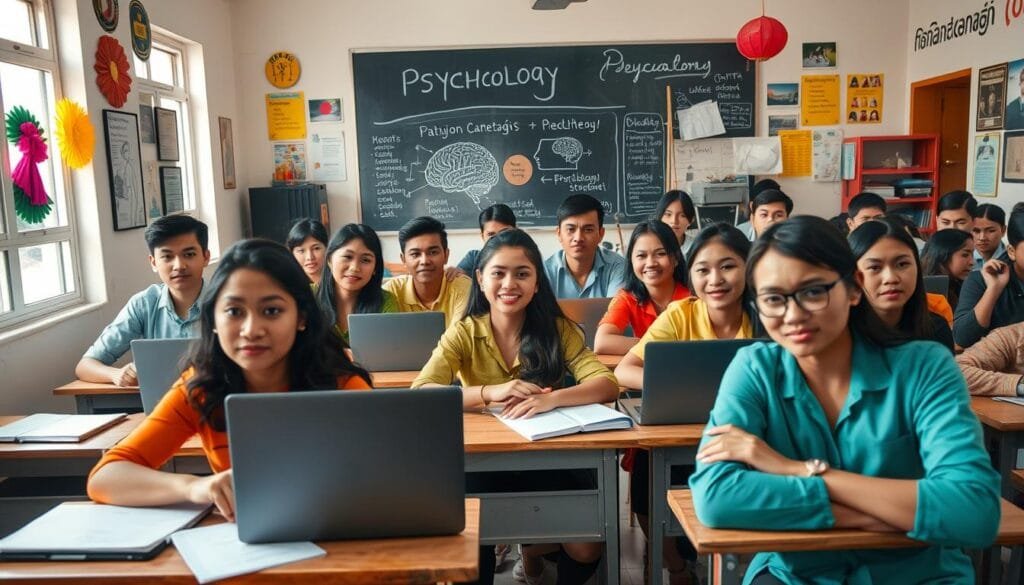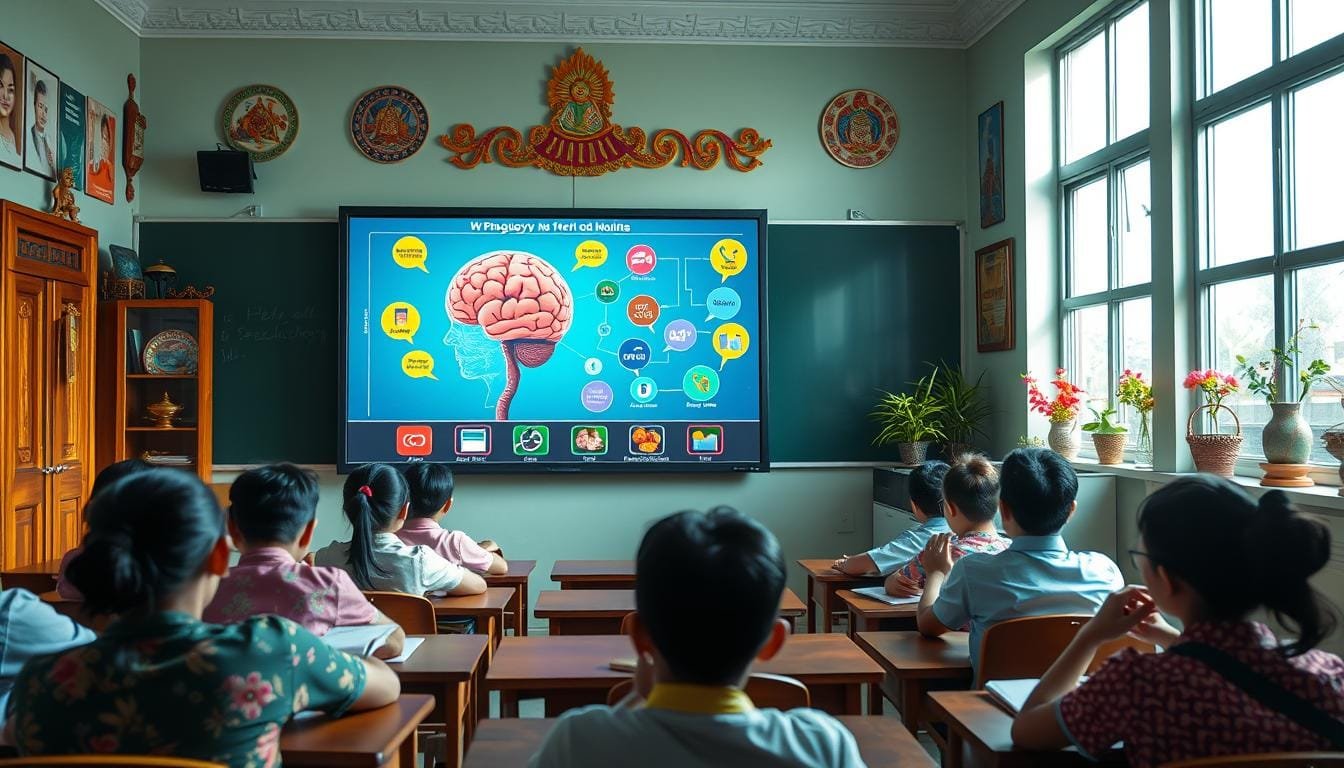Making educational videos on psychology learning introduces new ways to teach in Cambodia. It helps by addressing the real need for Khmer language instruction. The use of the local language in teaching can break down barriers, making these video tutorials essential. They are key in a country striving to improve its educational offerings1.
The TED-Ed social psychology videos show us that people want to learn about psychology in their own language. They’ve gotten a lot of views2. Adding to this, Cambodian teachers earn about $50 a month on average. This fact highlights how free educational materials can make a big difference in Cambodia’s learning environment2.
Key Takeaways
- Understanding the pivotal role of educational videos in bridging psychological concepts with Khmer language instruction.
- Recognizing the impact of comprehensive psychology learning resources on the educational front in Cambodia.
- Acknowledging the demand for video tutorials stemming from other successful educational video formats.
- Identifying the economic benefits of providing free, quality educational content in light of Cambodian educators’ salaries2.
- Highlighting the potential of educational videos to reach a broader audience amidst technological constraints in Cambodian educational institutions2.
Introduction to Educational Video Creation in Khmer
Mixing educational content creation with Cambodian schools is key. It’s crucial when using video learning to cover learning gaps. By creating educational videos, teachers give Khmer educational resources. These meet curriculum needs and the varied learning styles of Cambodian students.
Creating educational videos is about making learning fun, clear, and fitting for students. The American Intercon School shows how it’s done with their Khmer-American curriculum. It focuses on learning and growing in many ways, including how we think and feel3. This is really important for subjects like psychology that help students heal and grow from past traumas.
Workshops on making videos together have also helped. In Cambodia, these have been used to tackle tough topics like domestic violence. They bring communities together to heal. And they empower people to share their stories, making a big difference4.
The easy access to digital video gear has changed how we make and use educational materials. This helps bring real-world experiences into Cambodian educational content creation4.
When making educational videos, knowing the Khmer language and culture is essential. This makes sure the videos not only teach but also connect with local viewers. It’s a big part of improving education in Cambodia.
Looking at how places like American Intercon School check if their digital tools are working is interesting. They keep track of how many people use their resources each month. This shows a strong demand for digital learning in Cambodia3.
An interesting study shows schools are ready for the digital age in Cambodia3. They use video learning made for Cambodian students. This helps break through old barriers with new technology.
To wrap up, the push for Khmer educational resources and creating educational videos is growing. Technology and a deep respect for culture are leading the way. This is making education in Cambodia better all the time.
Why Psychology Education is Critical in Cambodia
In Cambodia, the shadows of a painful past linger. The country urgently needs strong psychological education. Healing minds, building resilience, and adapting education to Cambodian trauma are vital. This is because a war legacy that still haunts mental health today.
The Legacy of Trauma and the Need for Healing
Decades of conflict in Cambodia have left deep emotional scars. There’s a big need for ways to heal psychologically. Projects like “WE WANT (U) TO KNOW” use visual media to start healing talks. They show how vital educational videos are in healing psychologically.

Building Psychological Resilience in Communities
As Cambodia heals, giving communities psychological tools is key. The Trauma Healing Initiative developed ‘Tools for Trauma Recovery’. These efforts are crucial for teaching psychological care and boosting community support, helping people recover resiliently.
Addressing Mental Health with Localized Content
Cambodia’s high mental health issues link to its traumatic history. Education in Khmer and culturally relevant content is essential. This makes mental health education more accessible and effective. Tailored content provides support that truly connects with Cambodian mental health needs.
To heal as a nation, Cambodia must focus on psychological education. It’s key to healing, resilience, and offering relatable education. Such dedication paves the way for a healthier, stronger future.
Understanding Your Audience: Psychology Students in Cambodia
Making videos for psychology students in Cambodia means really understanding what they need to learn. These students have unique needs, rooted in Cambodia’s history and culture. This shapes what they need to learn academically and emotionally.

When we make content for these students, it’s key to include stuff they can relate to. This includes experiences from Cambodia’s history. There’s a big push in education there to use teaching resources that matter to them.
| Aspect | Details | Implications for Video Content |
|---|---|---|
| Educational Background | Most students enter with a high school diploma and are required to pass rigorous entrance examinations5. | Content needs to be foundational yet challenging, bridging the gap from high school to university-level psychology. |
| Course Requirements | Bachelor’s programs usually demand a minimum of 44 courses, equating to 132 credits5. | Videos should cover a broad spectrum of topics to mirror the comprehensive curriculum, ensuring a holistic learning experience. |
| Specialized Courses | Programs include ‘Introduction to Psychology’ which is pivotal for freshman year success5. | First-year videos should emphasize introductory concepts to build a strong foundation in psychology. |
Psychology students in Cambodia face unique challenges. Creating videos just for them helps meet their learning needs. This helps them grow into professionals who really make a difference in their communities.
Key Steps in Curriculum Development for Psychology Education
In curriculum development for the Khmer audience, the first step is finding key psychological ideas. This ensures students understand the basics they need for their studies and work in psychology. It’s important for teachers to mix classic and new psychological theories. This helps students get a wide view of the subject.
Identifying Core Psychological Concepts
Starting curriculum development means picking out important psychological concepts. This shapes the learning path and fits with Cambodia’s culture, making lessons more useful and relevant. Focusing on critical thinking and solving problems helps students tackle local issues well.
Adapting Material for the Khmer-speaking Audience
Adapting materials is not just translating. It’s about tailoring content to fit Cambodia’s culture, values, and norms. This makes complex psychology terms easier to understand, boosting how well students learn and remember6.

Incorporating Cambodia’s Cultural Context into Learning
Adding cultural context to lessons connects what’s taught to real life in Cambodia. This makes students more involved and helps them see how psychology affects their lives. The curriculum should have case studies from Cambodia’s past and present. These show the power of psychology in healing and unity7.
These steps help change psychology education in Cambodia. They make learning fit the culture and greatly aid in academic success and community health.
Technical Aspects of Video Production in Educational Content
Exploring how to make educational videos improves the learning journey. It’s crucial to pick the right gear, refine video edits for clear content, and make videos easy to understand through subtitles and translations. These steps are key for quality educational videos.
Choosing the Right Equipment
Choosing the best video production tools is key for top-notch educational materials. Using modern cameras and mics ensures great sound and picture. Experts often suggest specific setups for education needs8. These tech choices help capture and boost content, making learning more interactive and efficient8.
Editing Videos for Clarity and Engagement
Making sure video editing is on point is vital for clear content and keeping learners interested. Showing things directly and making videos straightforward helps students understand and remember better9. Adding various learning methods and thinking theories when editing greatly improves the learning experience9.
Adding Subtitles and Translations
Having videos easy to understand in many languages is important, especially where people speak different languages. Adding Khmer subtitles makes lessons accessible and boosts learning for those who don’t speak English. Services like Rask AI help make educational content understandable and relevant to Khmer speakers10. They play a big role in making education more welcoming for everyone10.
| Feature | Benefits | Impact on Learning |
|---|---|---|
| High-quality cameras and microphones | Enhanced audio and visual clarity | Improves learner engagement and content absorption |
| Professional video editing | Content clarity and structured learning | Enhances cognitive reception and educational outcomes |
| Subtitles in Khmer | Language accessibility and cultural relevance | Expands reach and inclusivity among Khmer-speaking learners |
How to Promote and Distribute Psychology Educational Videos
Effective video distribution and promotion of educational content need smart planning. For psychology videos, using different platforms and working together are key. This makes the content easy to find and use.
Increasing awareness about these videos starts with using data and insights. There were over 5,000 attacks on education between 2020 and 2021. This shows the need for educational content that’s safe and easy to access11. Programs like UNICEF’s Education in Emergencies and Education Cannot Wait are also important. They help keep education going during hard times11.
Here are steps to make video distribution inclusive and effective:
- Work with groups that focus on education and mental health support.
- Use social media to get people interested and share videos more.
- Mix online sharing with traditional ways like local showings and workshops.
- Make sure videos come in many forms and languages to help everyone learn.
Looking at the effects of focused video campaigns can offer insights. For example, after the Rwandan genocide, school completion rates dropped by 18.3%. This highlights the importance of education that meets specific needs in crisis situations11.
| Platform | Strategy | Expected Outcome |
|---|---|---|
| Social Media | Regular posts, interactive content | Broad engagement, high shareability |
| Educational Workshops | Direct engagement, hands-on activities | Deep understanding, practical application |
| Community Screenings | Local partnerships, inclusive settings | Community support, increased accessibility |
In conclusion, to promote and share educational videos well, understanding the situation and the learners’ needs is crucial. Using technology and partnerships creatively is also important for reaching many and making a big difference.
Conclusion
We are on a journey in educational video making, focusing on psychology education. This journey shows how learning in Cambodia can change. Making these videos helps fill a big need. It raises awareness about mental health and helps education grow in Cambodia. Three years ago, we saw there were not enough resources for adult language learners. They need easy-to-understand materials, which experts believe are very important12.
The goal is to make learning languages easier through videos. This idea is working well at places like Aristotle University of Thessaloniki and in Brazil13. So, these educational videos can do more than just teach; they can change how we think about and understand psychology.
Making videos is just the start. They help spark big changes in how people grasp psychological ideas. When teachers use different ways of teaching, like multimodal discourse analysis, it makes learning about psychology better13. For Cambodia, the key is not just making these videos. It’s also about seeing if they’re working and improving them based on people’s feedback.
So, the story of improving education in Cambodia is changing. It’s now about psychology education and making creative educational videos. These aren’t just learning tools. They’re signs of hope and a step towards healing. They help communities become stronger mentally. As Cambodia moves forward, every step taken changes the old sad stories into ones of power and growth. This shows how important education is in reviving a country and the strong spirit of its people.
FAQ
Why is there a need for psychology educational videos in the Khmer language?
Psychology videos in Khmer help native speakers learn easier. They address Cambodia’s tough past and aid in healing. These videos teach about mental health and strengthen the community’s emotional well-being.
How can educational videos address the legacy of trauma in Cambodia?
These videos teach about the mind in a way that makes sense for Cambodia’s history. They help people understand more, talk about their experiences, and start to heal. The goal is to help individuals and the community move past old hurts.
What considerations should be taken into account when creating psychology educational content for Cambodia?
When making these videos, it’s important to respect Cambodia’s culture. The content must be made especially for Cambodian learners. It should include local culture to make sure it’s relevant and easy to understand.
What are essential steps in developing a psychology curriculum for Cambodian learners?
First, choose main psychology ideas that are key. Then, make materials that speak to Khmer learners. Lastly, mix in Cambodian culture and values to make learning meaningful and relatable.
How important is the choice of technical equipment in producing educational videos?
Picking the right tech gear matters a lot. It makes the video quality better. This means using top-notch cameras, mics, and editing tools. Good equipment makes watching and learning a lot better.
What role does editing play in educational video production?
Editing makes sure the videos are fun to watch and easy to learn from. It means mixing different teaching tools, like slides and demos, to improve how well students learn.
How can educational videos be made accessible to non-English speaking audiences in Cambodia?
To reach everyone, videos need subtitles and translations in Khmer. This helps break down language barriers. It ensures students grasp even complex ideas in psychology.
What strategies can be used to promote the distribution of psychology educational videos?
To spread the videos, we should let people know they exist, share them wide and far, and work with schools, nonprofits, and community groups. This helps reach both teachers and learners all over.
